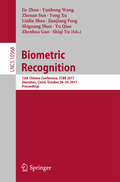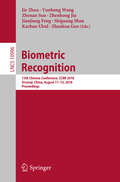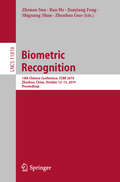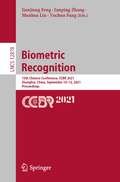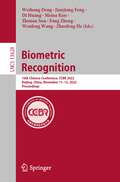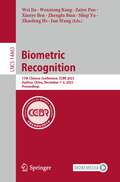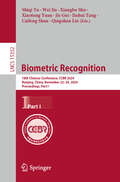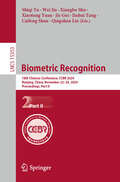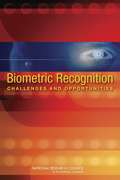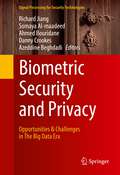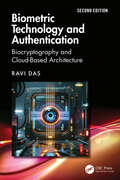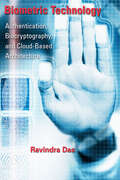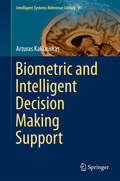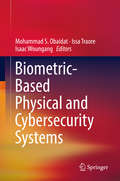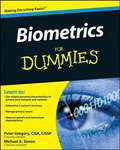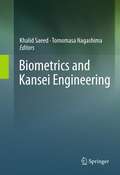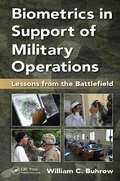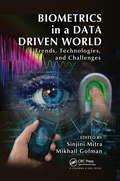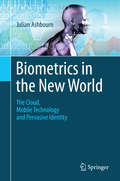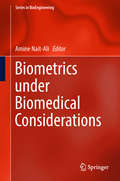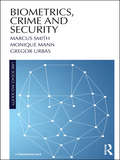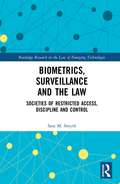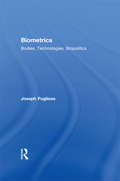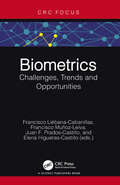- Table View
- List View
Biometric Recognition: 12th Chinese Conference, CCBR 2017, Shenzhen, China, October 28-29, 2017, Proceedings (Lecture Notes in Computer Science #10568)
by Jie Zhou Zhenhua Guo Yong Xu Shiguang Shan Yunhong Wang Zhenan Sun Jianjiang Feng Linlin Shen Yu Qiao Shiqi YuWith the increasing concerns on security breaches and transaction fraud, highly reliable and convenient personal verification and identification technologies are more and more requisite in our social activities and national services. Biometrics, used to recognize the identity of an individual, are gaining ever-growing popularity in an extensive array of governmental, military, forensic, and commercial security applications. ""Advanced Biometric Recognition Technologies: Discriminant Criterion and Fusion Applications"" focuses on two kinds of advanced biometric recognition technologies, biometric data discrimination and multi-biometrics, while systematically introducing recent research in developing effective biometric recognition technologies. Organized into three main sections, this cutting-edge book explores advanced biometric data discrimination technologies, describes tensor-based biometric data discrimination technologies, and develops the fundamental conception and categories of multi-biometrics technologies.
Biometric Recognition: 13th Chinese Conference, CCBR 2018, Urumqi, China, August 11-12, 2018, Proceedings (Lecture Notes in Computer Science #10996)
by Jie Zhou Zhenhua Guo Shiguang Shan Yunhong Wang Zhenan Sun Jianjiang Feng Zhenhong Jia Kurban UbulThe LNCS volume 10996 constitutes the proceedings of the 13th Chinese Conference on Biometric Recognition, held in Urumchi, China, in August 2018. The 79 full papers and 67 poster papers presented were carefully reviewed and selected from 112 submissions. The papers cover a wide range of topics such as Biometrics, Speech recognition, Activity recognition and understanding, Online handwriting recognition, System forensics, Multi-factor authentication, Graphical and visual passwords.
Biometric Recognition: 14th Chinese Conference, CCBR 2019, Zhuzhou, China, October 12–13, 2019, Proceedings (Lecture Notes in Computer Science #11818)
by Ran He Zhenhua Guo Shiguang Shan Zhenan Sun Jianjiang FengThe LNCS volume 11818 constitutes the proceedings of the 14th Chinese Conference on Biometric Recognition, held in Zhuzhou, China, in October 2019. The 56 papers presented in this book were carefully reviewed and selected from 74 submissions. The papers cover a wide range of topics such as face recognition and analysis; hand-based biometrics; eye-based biometrics; gesture, gait, and action; emerging biometrics; feature extraction and classification theory; and behavioral biometrics.
Biometric Recognition: 15th Chinese Conference, CCBR 2021, Shanghai, China, September 10–12, 2021, Proceedings (Lecture Notes in Computer Science #12878)
by Jianjiang Feng Junping Zhang Manhua Liu Yuchun FangThe LNCS volume 12878 constitutes the proceedings of the 15th Chinese Conference on Biometric Recognition, held in Shanghai, China, in September 2021.The 53 papers presented in this book were carefully reviewed and selected from 72 submissions. The papers cover a wide range of topics such as multi-modal biometrics and emerging biometrics; hand biometrics; facial biometrics; and speech biometrics.
Biometric Recognition: 16th Chinese Conference, CCBR 2022, Beijing, China, November 11–13, 2022, Proceedings (Lecture Notes in Computer Science #13628)
by Zhenan Sun Jianjiang Feng Wenfeng Wang Meina Kan Weihong Deng Di Huang Fang Zheng Zhaofeng HeThis book constitutes the proceedings of the 16th Chinese Conference on Biometric Recognition, CCBR 2022, which took place in Beijing, China, in November 2022.The 70 papers presented in this volume were carefully reviewed and selected from 115 submissions. The papers cover a wide range of topics such as Fingerprint, Palmprint and Vein Recognition; Face Detection, Recognition and Tracking; Gesture and Action Recognition; Affective Computing and Human-Computer Interface; Speaker and Speech Recognition; Gait, Iris and Other Biometrics; Multi-modal Biometric Recognition and Fusion; Quality Evaluation and Enhancement of Biometric Signals; Animal Biometrics; Trustworthy, Privacy and Personal Data Security; Medical and Other Applications.
Biometric Recognition: 17th Chinese Conference, CCBR 2023, Xuzhou, China, December 1–3, 2023, Proceedings (Lecture Notes in Computer Science #14463)
by Jun Wang Shiqi Yu Zhaofeng He Wei Jia Wenxiong Kang Zaiyu Pan Xianye Ben Zhengfu BianThis book constitutes the proceedings of the 17th Chinese Conference, CCBR 2023, held in Xuzhou, China, during December 1–3, 2023. The 41 full papers included in this volume were carefully reviewed and selected from 79 submissions. The volume is divided in topical sections named: Fingerprint, Palmprint and Vein Recognition; Face Detection, Recognition and Tracking; Affective Computing and Human-Computer Interface; Trustworthy, Privacy and Personal Data Security; Medical and Other Applications.
Biometric Recognition: 18th Chinese Conference, CCBR 2024, Nanjing, China, November 22–24, 2024, Proceedings, Part I (Lecture Notes in Computer Science #15352)
by Caifeng Shan Xiaotong Yuan Qingshan Liu Shiqi Yu Jinhui Tang Wei Jia Xiangbo Shu Jie GuiThis two-volume set, LNCS 15352 and LNCS 15353, constitutes the proceedings of the 18th Chinese Conference on Biometric Recognition, CCBR 2024, held in Nanjing, China, during November 22–24, 2024. The 52 full papers presented here were carefully reviewed and selected from 82 submissions. These papers have been categorized under the following topical sections in these two volumes: - Part I: Fingerprint, Palmprint and Vein Recognition; Face Detection, Recognition and Tracking. Part II: Face Detection, Recognition and Tracking; Affective Computing and Human-Computer Interface; Gait, Iris and Other Biometrics; Trustworthy, Privacy and Personal Data Security; Medical and Other Applications.
Biometric Recognition: 18th Chinese Conference, CCBR 2024, Nanjing, China, November 22–24, 2024, Proceedings, Part II (Lecture Notes in Computer Science #15353)
by Caifeng Shan Xiaotong Yuan Qingshan Liu Shiqi Yu Jinhui Tang Wei Jia Xiangbo Shu Jie GuiThis two-volume set, LNCS 15352 and LNCS 15353, constitutes the proceedings of the 18th Chinese Conference on Biometric Recognition, CCBR 2024, held in Nanjing, China, during November 22–24, 2024. The 52 full papers presented here were carefully reviewed and selected from 82 submissions. These papers have been categorized under the following topical sections in these two volumes: - Part I: Fingerprint, Palmprint and Vein Recognition; Face Detection, Recognition and Tracking. Part II: Face Detection, Recognition and Tracking; Affective Computing and Human-Computer Interface; Gait, Iris and Other Biometrics; Trustworthy, Privacy and Personal Data Security; Medical and Other Applications.
Biometric Recognition: Challenges and Opportunities
by National Research Council of the National AcademiesBiometric recognition--the automated recognition of individuals based on their behavioral and biological characteristic--is promoted as a way to help identify terrorists, provide better control of access to physical facilities and financial accounts, and increase the efficiency of access to services and their utilization. Biometric recognition has been applied to identification of criminals, patient tracking in medical informatics, and the personalization of social services, among other things. In spite of substantial effort, however, there remain unresolved questions about the effectiveness and management of systems for biometric recognition, as well as the appropriateness and societal impact of their use. Moreover, the general public has been exposed to biometrics largely as high-technology gadgets in spy thrillers or as fear-instilling instruments of state or corporate surveillance in speculative fiction. Now, as biometric technologies appear poised for broader use, increased concerns about national security and the tracking of individuals as they cross borders have caused passports, visas, and border-crossing records to be linked to biometric data. A focus on fighting insurgencies and terrorism has led to the military deployment of biometric tools to enable recognition of individuals as friend or foe. Commercially, finger-imaging sensors, whose cost and physical size have been reduced, now appear on many laptop personal computers, handheld devices, mobile phones, and other consumer devices. Biometric Recognition: Challenges and Opportunities addresses the issues surrounding broader implementation of this technology, making two main points: first, biometric recognition systems are incredibly complex, and need to be addressed as such. Second, biometric recognition is an inherently probabilistic endeavor. Consequently, even when the technology and the system in which it is embedded are behaving as designed, there is inevitable uncertainty and risk of error. This book elaborates on these themes in detail to provide policy makers, developers, and researchers a comprehensive assessment of biometric recognition that examines current capabilities, future possibilities, and the role of government in technology and system development.
Biometric Security and Privacy: Opportunities & Challenges in The Big Data Era (Signal Processing for Security Technologies)
by Ahmed Bouridane Richard Jiang Somaya Al-Maadeed Danny Crookes Azeddine BeghdadiThis book highlights recent research advances on biometrics using new methods such as deep learning, nonlinear graph embedding, fuzzy approaches, and ensemble learning. Included are special biometric technologies related to privacy and security issues, such as cancellable biometrics and soft biometrics. The book also focuses on several emerging topics such as big data issues, internet of things, medical biometrics, healthcare, and robot-human interactions. The authors show how these new applications have triggered a number of new biometric approaches. They show, as an example, how fuzzy extractor has become a useful tool for key generation in biometric banking, and vein/heart rates from medical records can also be used to identify patients. The contributors cover the topics, their methods, and their applications in depth.
Biometric State
by Keith BreckenridgeGroundbreaking study of South Africa's role as a site for global experiments in biometric identification throughout the twentieth century.
Biometric Technology and Authentication: Biocryptography and Cloud-Based Architecture
by Ravi DasThis book is an update to the first edition of this book. Some of the updates include newer images and an extensive review as to how both AWS and Microsoft Azure can be used to host a biometrics in the cloud infrastructure, which will be a hot topic going into 2025 and beyond. Finally, the last chapter of this book previews some of the latest trends for biometric technology going into 2025 and beyond.
Biometric Technology: Authentication, Biocryptography, and Cloud-Based Architecture
by Ravi DasMost biometric books are either extraordinarily technical for technophiles or extremely elementary for the lay person. Striking a balance, this book is geared toward the business, IT, or security manager required to make purchasing, migration, or adoption decisions. Presenting technical background on the various biometric technologies and how they work, it looks at optimal application in various settings and their respective strengths and weaknesses considering ease of use, false positives and negatives, and privacy and security issues. It also discusses exciting trends in biotechnology such as biocryptography and biometrics in the cloud.
Biometric and Intelligent Decision Making Support (Intelligent Systems Reference Library #81)
by Arturas KaklauskasThis book presents different methods for analyzing the body language (movement, position, use of personal space, silences, pauses and tone, the eyes, pupil dilation or constriction, smiles, body temperature and the like) for better understanding people's needs and actions, including biometric data gathering and reading. Different studies described in this book indicate that sufficiently much data, information and knowledge can be gained by utilizing biometric technologies. This is the first, wide-ranging book that is devoted completely to the area of intelligent decision support systems, biometrics technologies and their integrations. This book is designated for scholars, practitioners and doctoral and master's degree students in various areas and those who are interested in the latest biometric and intelligent decision making support problems and means for their resolutions, biometric and intelligent decision making support systems and the theory and practice of their integration and the opportunities for the practical use of biometric and intelligent decision making support.
Biometric-Based Physical and Cybersecurity Systems
by Isaac Woungang Mohammad S. Obaidat Issa TraoreThis book presents the latest developments in biometrics technologies and reports on new approaches, methods, findings, and technologies developed or being developed by the research community and the industry. The book focuses on introducing fundamental principles and concepts of key enabling technologies for biometric systems applied for both physical and cyber security. The authors disseminate recent research and developing efforts in this area, investigate related trends and challenges, and present case studies and examples such as fingerprint, face, iris, retina, keystroke dynamics, and voice applications . The authors also investigate the advances and future outcomes in research and development in biometric security systems. The book is applicable to students, instructors, researchers, industry practitioners, and related government agencies staff. Each chapter is accompanied by a set of PowerPoint slides for use by instructors.
Biometrics For Dummies
by Michael A. Simon Peter H. GregoryWhat is biometrics? Whether you're just curious about how biometrics can benefit society or you need to learn how to integrate biometrics with an existing security system in your organization, Biometrics For Dummies can help.Here's a friendly introduction to biometrics -- the science of identifying humans based on unique physical characteristics. With the government's use of biometrics -- for example, biometric passport readers -- and application of the technology for law enforcement, biometrics is growing more popular among security experts. Biometrics For Dummies explains biometric technology, explores biometrics policy and privacy issues with biometrics, and takes a look at where the science is heading. You'll discover:How pattern recognition and fingerprint recognition are usedThe many vulnerabilities of biometric systems and how to guard against themHow various countries are handling the privacy issues and what can be done to protect citizens' privacyHow a scan of the palm, veins in the hand, and sonar imagery establish identityWhat it takes to fully authenticate a signatureHow gait, speech, linguistic analysis, and other types of biometric identification come into playThe criteria for setting up an implementation planHow to use authentication, authorization, and access principlesWritten by a pair of security experts, Biometrics For Dummies gives you the basics in an easy-to-understand format that doesn't scrimp on substance. You'll get up to speed and enjoy getting there!
Biometrics and Kansei Engineering
by Tomomasa Nagashima Khalid SaeedBiometrics and Kansei Engineering is the first book to bring together the principles and applications of each discipline. The future of biometrics is in need of new technologies that can depend on people's emotions and the prediction of their intention to take an action. Behavioral biometrics studies the way people walk, talk, and express their emotions, and Kansei Engineering focuses on interactions between users, products/services and product psychology. They are becoming quite complementary. This book also introduces biometric applications in our environment, which further illustrates the close relationship between Biometrics and Kansei Engineering. Examples and case studies are provided throughout this book. Biometrics and Kansei Engineering is designed as a reference book for professionals working in these related fields. Advanced-level students and researchers studying computer science and engineering will find this book useful as a reference or secondary text book as well.
Biometrics in Support of Military Operations: Lessons from the Battlefield
by William C. BuhrowBiometrics in Support of Military Operations: Lessons from the Battlefield examines and evaluates recent U.S. military experiences in Iraq and Afghanistan in the context of the use of biometrics and related technologies. The book takes a comprehensive look at how biometrics has been used to support various military operations and suggests ways that its uses can be further developed. It fills a void in understanding how to incorporate biometrics by providing a guide to develop and establish formal operational roles and procedures when applying the technology. Written in an informal style that makes it accessible to people who are not necessarily operators or technicians of biometrics technologies, this book bridges an existing gap to better educate leaders inside and outside of the U.S. military on the far-reaching potential of biometrics in support of tactical operations. It argues that the gap between those inside and outside the military is the result of failure to document lessons learned from battle experience, as well as a lack of a combined vision among the Joint Forces to fully recognize and exploit the capabilities of biometrics for enhanced future success. This book fills that gap. Biometrics has great potential as an effective tool if properly developed and utilized. The book concludes with a look at the future of emerging applications for the military but also considers a wider range of deployment of biometrics outside the military, such as in governmental organizations, including foreign diplomacy. Biometrics can be applied to any operational area that requires accurate and rapid identification of unknown individuals in order to support its operations and protect personnel and resources. Biometrics in Support of Military Operations is an important beginning point in an emerging field for gaining understanding and better mastery of biometrics.
Biometrics in a Data Driven World: Trends, Technologies, and Challenges
by Sinjini Mitra and Mikhail GofmanBiometrics in a Data Driven World: Trends, Technologies, and Challenges aims to inform readers about the modern applications of biometrics in the context of a data-driven society, to familiarize them with the rich history of biometrics, and to provide them with a glimpse into the future of biometrics. The first section of the book discusses the fundamentals of biometrics and provides an overview of common biometric modalities, namely face, fingerprints, iris, and voice. It also discusses the history of the field, and provides an overview of emerging trends and opportunities. The second section of the book introduces readers to a wide range of biometric applications. The next part of the book is dedicated to the discussion of case studies of biometric modalities currently used on mobile applications. As smartphones and tablet computers are rapidly becoming the dominant consumer computer platforms, biometrics-based authentication is emerging as an integral part of protecting mobile devices against unauthorized access, while enabling new and highly popular applications, such as secure online payment authorization. The book concludes with a discussion of future trends and opportunities in the field of biometrics, which will pave the way for advancing research in the area of biometrics, and for the deployment of biometric technologies in real-world applications. The book is designed for individuals interested in exploring the contemporary applications of biometrics, from students to researchers and practitioners working in this field. Both undergraduate and graduate students enrolled in college-level security courses will also find this book to be an especially useful companion.
Biometrics in the New World: The Cloud, Mobile Technology and Pervasive Identity
by Julian AshbournThis book takes a fresh look at biometrics and identity management, extending the dialogue beyond technical considerations, and exploring some of the broader societal and philosophical aspects surrounding the use of biometric applications. Features: presents a brief history of the development of biometrics, and describes some of the popularly held misconceptions surrounding the technology; investigates the challenges and possibilities of biometrics across third party infrastructures and on mobile computing devices; provides guidance on biometric systems design; explores the mechanisms necessary to enable identity intelligence, including logging mechanisms, data communications and data formats; discusses such usage issues as collaboration frameworks, and messaging and data translation; examines the impact of biometric technologies on society, covering issues of privacy and user factors; reviews the current situation in identity management, and predicts where these trends may take us in the future.
Biometrics under Biomedical Considerations (Series in BioEngineering)
by Amine Nait-Ali<p>This book addresses biometrics from a biomedical engineering point of view. Divided into five sections, it discusses topics including the influence of pathologies on various biometric modalities (e.g. face, iris, fingerprint), medical and security biometrics, behavioural biometrics, instrumentation, wearable technologies and imaging. The final chapters also present a number of case studies. <p>The book is suitable for advanced graduate and postgraduate students, engineers and researchers, especially those in signal and image processing, biometrics, and biomedical engineering.</p>
Biometrics, Crime and Security (Law, Science and Society)
by Marcus Smith Monique Mann Gregor UrbasThis book addresses the use of biometrics – including fingerprint identification, DNA identification and facial recognition – in the criminal justice system: balancing the need to ensure society is protected from harms, such as crime and terrorism, while also preserving individual rights. It offers a comprehensive discussion of biometric identification that includes a consideration of: basic scientific principles, their historical development, the perspectives of political philosophy, critical security and surveillance studies; but especially the relevant law, policy and regulatory issues. Developments in key jurisdictions where the technology has been implemented, including the United Kingdom, United States, Europe and Australia, are examined. This includes case studies relating to the implementation of new technology, policy, legislation, court judgements, and where available, empirical evaluations of the use of biometrics in criminal justice systems. Examples from non-western areas of the world are also considered. Accessibly written, this book will be of interest to undergraduate, postgraduate and research students, academic researchers, as well as professionals in government, security, legal and private sectors.
Biometrics, Surveillance and the Law: Societies of Restricted Access, Discipline and Control (Routledge Research in the Law of Emerging Technologies)
by Sara M. SmythThe use of biometric identification systems is rapidly increasing across the world, owing to their potential to combat terrorism, fraud, corruption and other illegal activities. However, critics of the technology complain that the creation of an extensive central register of personal information controlled by the government will increase opportunities for the state to abuse citizens. There is also concern about the extent to which data about an individual is recorded and kept. This book reviews some of the most current and complex legal and ethical issues relating to the use of biometrics. Beginning with an overview of biometric systems, the book goes on to examine some of the theoretical underpinnings of the surveillance state, questioning whether these conceptual approaches are still relevant, particularly the integration of ubiquitous surveillance systems and devices. The book also analyses the implementation of the world’s largest biometric database, Aadhaar, in detail. Additionally, the identification of individuals at border checkpoints in the United States, Australia and the EU is explored, as well as the legal and ethical debates surrounding the use of biometrics regarding: the war on terror and the current refugee crisis; violations of international human rights law principles; and mobility and privacy rights. The book concludes by addressing the collection, use and disclosure of personal information by private-sector entities such as Axciom and Facebook, and government use of these tools to profile individuals. By examining the major legal and ethical issues surrounding the debate on this rapidly emerging technology, this book will appeal to students and scholars of law, criminology and surveillance studies, as well as law enforcement and criminal law practitioners.
Biometrics: Bodies, Technologies, Biopolitics (Routledge Studies in Science, Technology and Society)
by Joseph PuglieseBiometric technologies, such as finger- or facial-scan, are being deployed across a variety of social contexts in order to facilitate and guarantee identity verification and authentication. In the post-9/11 world, biometric technologies have experienced an extraordinary period of growth as concerns about security and screening have increased. This book analyses biometric systems in terms of the application of biopolitical power – corporate, military and governmental – on the human body. It deploys cultural theory in examining the manner in which biometric technologies constitute the body as a target of surveillance and as a data-information object. The book thereby provides a comprehensive overview and critical analysis of both the local and global ramifications of biometric technologies.
Biometrics: Challenges, Trends and Opportunities
by Elena Higueras-Castillo Francisco Liébana-Cabanillas Francisco Muñoz-Leiva Juan F. Prados-CastilloThe book provides a comprehensive overview of biometrics, including its theoretical foundations and practical applications, and offers valuable insights into its relevance and impact on various sectors of society. It provides readers with a comprehensive view of how biometrics can shape future solutions that are secure, user focused, and technologically advanced. The first part discusses the fundamentals and applications of biometric technology. The second part discusses the challenges and future of biometric technologies.
